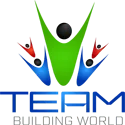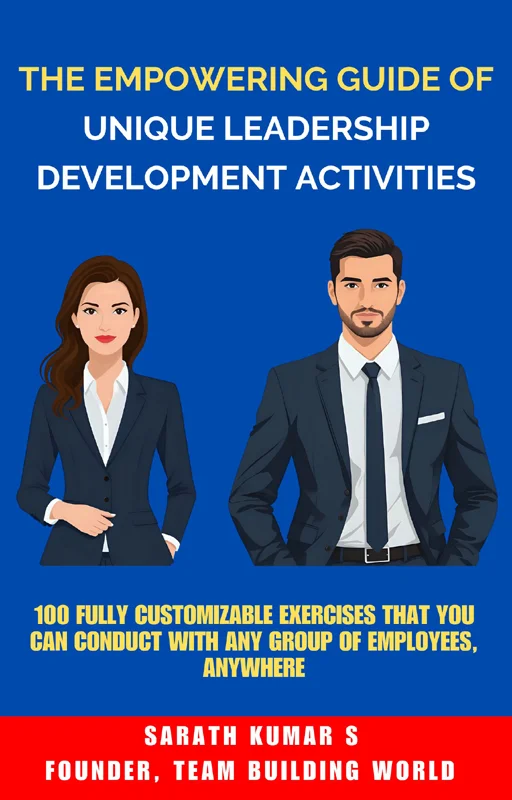10 Adaptive Leadership Group Activities (With Debrief)
Are you in search of some adaptive leadership activities?
Since the workplaces are changing day by day, adaptive leadership is not just a skill but a necessity. As a leader, you must equip your employees to handle unexpected challenges and guide your organization through change.
In this article, let’s see 10 activities that you can try in your workplace to cultivate adaptive leadership among your teams.
10 Adaptive Leadership Group Activities
Here are some engaging group activities that can help foster adaptive leadership skills among your employees:
#1. Shipwreck Simulation
This is a dynamic activity designed to sharpen decision-making and teamwork skills by selecting survival items after a simulated shipwreck.
Time: 10-15 minutes
Materials: List of survival items
Participants: 4-8 people per group
Instructions
- Present the scenario to the groups: they have been in a shipwreck and have landed on a deserted island with only a limited list of survival items.
- Give each group the list of survival items like a first aid kit, water purifiers, fishing gear, etc.
- Then, ask them to prioritize the five most essential items for their survival.
- Once the groups have made their decisions, ask them to present and justify their choices.
Debrief
During the debrief, focus on the decision-making processes and the importance of consensus in challenging situations. Highlight how diverse strategies can lead to innovative problem-solving under stress.
You can also read: The 10 Best Adaptive Leadership Books
#2. Change Wind Tunnel
This exercise challenges teams to stay agile and responsive amid a series of unexpected changes, fostering adaptability and resilience.
Time: 15-20 minutes
Materials: None
Participants: Any group size
Instructions
- Begin with a simple task for each team to execute. For example, building a structure with blocks or solving a puzzle.
- Periodically introduce new “wind changes” — alterations to the original task or completely new tasks. For example, tasks could involve building with a limited number of blocks or solving the puzzle blindfolded.
- Encourage teams to communicate effectively and adapt their strategies to successfully complete the task at hand.
Debrief
Discuss how teams responded to the various changes and what strategies they used to adapt. Emphasize the importance of flexibility and quick thinking in a constantly changing environment.
#3. Reverse Brainstorming
This activity flips traditional problem-solving on its head by identifying potential failures to foster creativity and strategic planning.
Time: 10-15 minutes
Materials: Notepads and pens
Participants: 4-8 people per group
Instructions
- Present a common issue related to your team’s current project and instruct groups to list all possible ways to make the issue worse. For example, if the issue is a communication breakdown, possible ways to make it worse could be giving conflicting instructions or not responding to emails.
- Encourage wild and out-of-the-box ideas to emphasize the no-judgment phase of brainstorming.
- Have each group share their “worst-case scenarios” with everyone.
- Together, review these scenarios to identify preventive strategies and innovative solutions.
Debrief
The debrief should uncover hidden assumptions and risk areas in current plans. It’s an opportunity to reinforce the importance of contingency planning and the value of considering what might go wrong to ensure success.
#4. The Change Ambassador
This exercise is all about empowering an individual to lead a small but impactful change in the workplace every week.
Time: 1 week
Materials: Idea submission box, and feedback forms
Participants: 1 ambassador per week, whole team involved
Instructions
- Begin by nominating the week’s Change Ambassador through a team vote or rotation.
- The Ambassador selects one feasible change to implement, focusing on improving team dynamics or work processes. For example, introducing a daily stand-up meeting to enhance communication.
- Implement the change throughout the week, gathering informal feedback along the way.
- At the week’s end, collect formal feedback using feedback forms to assess the change’s impact.
Debrief
The debrief focuses on evaluating the effectiveness of the implemented change and its reception by the team. It’s crucial to identify the lessons learned and decide whether the change should be adopted long-term or adjusted for the future.
#5. Scenario Planning
This is a forward-thinking exercise where teams collaboratively envision and plan for possible future challenges. It strengthens their strategic thinking and adaptability.
Time: Half-day
Materials: Whiteboards, markers, scenario cards, and voting stickers
Participants: Entire team, divided into small groups
Instructions
- Kick off by dividing the team into groups, each assigned specific future scenarios to analyze. For example, a potential technological disruption or economic downturn.
- Each group brainstorms and discusses the implications of their assigned scenario, writing down key ideas as well as strategies on whiteboards.
- After a set amount of time, each group presents their ideas to the larger team.
- Using voting stickers, the team collectively decides on the most likely scenario and corresponding strategies to address it.
Debrief
During the debrief, it’s essential to collectively reflect on the realism and feasibility of the strategies devised. The goal is to identify key takeaways that can be integrated into the organization’s strategic planning process.
#6. Feedback Circle
This activity is aimed at fostering a culture of constructive feedback, promoting continuous learning, and enhancing adaptability within the team. It is one of the amazing adaptive leadership group activities.
Time: 10-15 minutes
Materials: None
Participants: 3-6 members per group
Instructions
- Begin the session with participants forming small, intimate groups to ensure a safe, supportive environment.
- Each participant takes turns sharing one specific area of their work they would like feedback on. This could range from communication skills to project management techniques.
- The rest of the group, having listened carefully, provides constructive feedback. This feedback should be specific, actionable, and focused on behavior rather than personality.
- Participants then discuss the feedback together, exploring ways to implement suggestions and improve their performance.
Debrief
Conclude with a group discussion on the experience of giving and receiving feedback. Highlight the importance of constructive communication and how it can be used as a tool for personal as well as professional growth.
#7. Leadership Shadowing
This is a dynamic initiative designed to expose employees to diverse leadership styles and challenges. It promotes adaptability and personal growth in a real-world setting.
Time: Full day
Materials: Notebook for reflections
Participants: 1 team member per leader
Instructions
- Match each participating team member with a leader, ideally in a role or with responsibilities they aspire to understand.
- Participants spend a day observing their assigned leader, taking note of decision-making processes, communication styles, and problem-solving techniques.
- Encourage participants to engage in reflective observation by writing down key insights, questions, and observations throughout the day.
- Facilitate a one-on-one discussion between the participant and the leader at the end of the day. Then, they can discuss observations and ask questions directly.
Debrief
During the debrief, encourage participants to share their reflections and insights with the broader team. Highlight the diversity in leadership styles encountered and extract actionable lessons that can foster personal as well as professional development.
#8. Scenario Sprint
The Scenario Sprint is an exhilarating exercise designed to enhance agility and decision-making in the face of unforeseen challenges. It is one of the best adaptive leadership activities.
Time: 15-20 minutes
Materials: Scenario cards, and timer
Participants: 3-8 individuals in a group
Instructions
- Divide the participants into small teams and hand out scenario cards depicting various unexpected business challenges. For example, a sudden shift in consumer behavior or a supply chain disruption.
- Set a timer for 5 minutes and have the teams quickly come up with their response plan to the given scenario.
- When the time is up, have each team present their approach and rationale for handling the scenario.
- Repeat the process with different scenarios, gradually reducing the time limit to increase the pressure and simulate real-life situations.
Debrief
Evaluate the strategies developed, focusing on the creativity, practicality, and efficiency of responses. Discuss the importance of adaptability and swift problem-solving in achieving business resilience.
#9. Role Reversal Debate
The Role Reversal Debate is a spirited exercise that fosters empathy and adaptable thinking. Here the employees engage in argument preparation and presentation on opposing views.
Time: You decide
Materials: Debate topics, notepads, and pens
Participants: Groups of 3-6 members
Instructions
- Split the participants into teams, assigning each a different side of a debated issue.
- Give teams time to research their positions, craft arguments, and anticipate counterarguments. Example issues could range from “remote vs. in-office work” to “innovation vs. tradition in business strategy.”
- Have each team present their arguments in a structured debate format, allowing for rebuttals and questions from the opposing team.
- Conclude with a voting session on the most persuasive argument, emphasizing the importance of the debate over the winning side.
Debrief
During the debrief, explore the shift in perspectives and the newfound understanding team members gained about perspectives other than their own. Highlight the value of considering and respecting diverse viewpoints to foster a collaborative team environment.
#10. Cultural Exchange
The Cultural Exchange is a dynamic activity that helps with adaptability in understanding and celebrating differences.
Time: Flexible
Materials: None
Participants: Any group size
Instructions
- Invite participants to prepare a brief share about their cultural background or a personal interest.
- Organize a session where each person presents their story, using objects, photos, or any preferred method to enhance their narrative.
- Encourage respectful and curious questions from other team members.
- Conclude with a discussion on the importance of diversity, inclusion, and understanding in fostering a positive as well as collaborative work environment.
Debrief
Reflect on the variety of experiences shared and the insights gained into the different backgrounds of team members. Highlight the importance of empathy and open-mindedness in building a truly inclusive as well as adaptive team.
Want Some Unique Leadership Development Activities?
If you want some unique activities to equip your employees with leadership skills, qualities, and mindset, you can get my new e-book:
Or Want Some Unique Team Building Activities?
If you want some unique activities for your employees (both in-person and virtual), you can get my new e-book:adaptive leadership group activities
Final Words
In wrapping up, it’s crucial to understand the power of adaptive leadership in transforming your work environment. These exercises are more than just games; they are a bridge to deeper understanding, mutual respect, and enhanced collaboration among employees. By regularly incorporating these activities into your routines, you can set a foundation for a dynamic, inclusive, and resilient organization.

